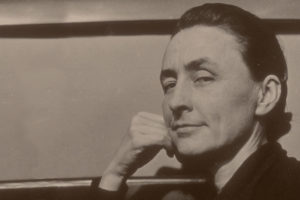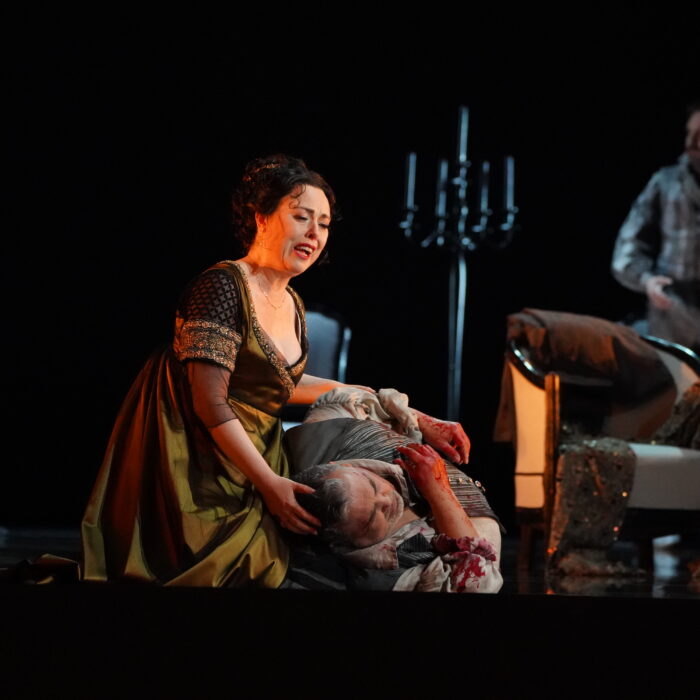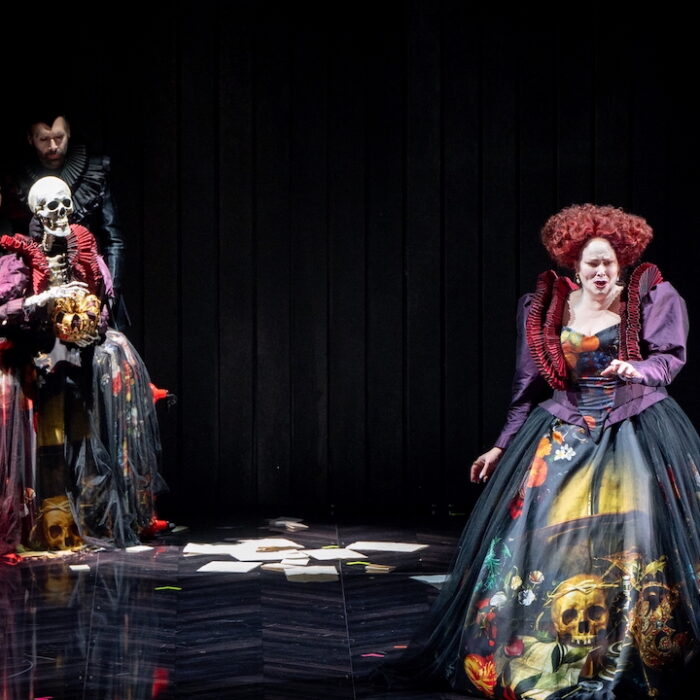
Opera Parallèle 2019-19 Review: Today It Rains
Opera Parallele brings Visual Art to the Stage
By Lois SilversteinLaura Kaminsky, Mark Campbell, and Kimberly Reed’s “Today It Rains,” Opera Parallèle’s Chamber Opera train trip with Georgia O’Keeffe, premiered in San Francisco with a lot of hoopla.
From New York’s Penn Station to Santa Fe’s Lamy Station, a journey from romance with heartache to open sky and liberation, the company offered a fresh take on some of O’Keeffe’s artistic and personal choices. While the subject of an artist seeking a new voice and seeking a new and unencumbered landscape to express it is not news today, Opera Parallèle mounted a production that made it seem so.
In the 1929 in which it was set, O’Keeffe wrote to Alfred Stieglitz, the well-known photographer, when she left him, ““… I chose coming away because here at least I feel good – and it makes me feel I am growing very tall and straight inside – and very still…” The vibrant world that sprang forth from O Keeffe’s canvases as a result – gigantic red canna and stark white skulls – set into the electric landscape of the American Southwest, showing both self and her audiences that it was the right choice for her and American Art. This theme, set to Laura Kaminsky’s dynamic opera score, made for a production that fit multiple artistic elements together at Z Space, San Francisco into a tidy, if over-active, package.
Always On The Go
A type of short story, “Today It Rains” is a historical moment set in motion. The 85 minute one-act never stopped moving.
Kaminsky’s score was replete with syncopation and picturesque textures. Scored for only 11 instruments, including trombone and saxophone and clarinet, plus strings, flute and percussion, under the baton of Nicole Paiement, we found diversity, richness, and much originality. There was also a lot of Americana – the jazzy clarinet, the sexy saxophone, square dance and band music, plus some sensuous strings. Percussive diversity kept the pulse of the train and the psychological conflicts moving, thus matching the whole journey.While it began with a slow and ample taste of melancholy, it then proceeded to unfold with liveliness that continued to the very end.
Nicole Paiement led her musicians with aplomb, her own energetic movement paralleling the textures that shifted from scene to scene in dramatic fashion. The dark chords of the opening, the pensive and brooding, slow sound seemed odd for a scene of gathering for a long journey, coupled with a sheet of rain falling behind it upstage; and the arrival of passengers took more time than needed to initiate the excitement and anticipation. When Kaminsky’s reflectiveness, however, turned into that hustle and bustle, activity increased and at a rapid pace. In so many ways, the music was not simply the heart of the production but the key actor.
Elaborate & Static
The elaborate production was created and staged by Director Brian Staufenbiel and Assistant Director David Toro. It featured ever-shifting scenes of New York and the train journey itself; Sean Riley did the elaborate and original Set Design and Lighting Design was by Alexander V. Nichols.
The projections, complete with weather and landscape highpoints and constantly changing foci, were done by Kimberly Reed. In addition, Reed included an original shadow play, and geographic shots of the U.S.A. as the train headed West. That said, despite the apparent story line, character development took a back seat to the display and the intense activity. Was the main intent to keep the focus on this activity rather than the emotional, psychological challenge? It was as if a Virginia Woolf story was told in quick-silver speed than a more life-life one.
Georgia O’Keefe was a genius. An icon for art. An icon for a generation – an imaginative and daring artist whose extraordinary works still continue to dazzle. To make an opera out of her life fits in an age of biopics and the cult of the star, political, artistic, sport. romanticization of artists, politicians, leaders, and so on. Still, we learned what was on Georgia’s mind despite all this but felt it more as a promise as the scenes unfolded. We didn’t get close to the emotional life of the promise despite being told about it many times and ways. The libretto, The libretto by Mark Campbell and Kimberley Reed, developed the story through narrative with several turning points rather than more probing dramatization. The result seemed like a Christmas tree resplendent with colorful baubles, static, despite its emphasis on movement.
A Strong O’Keefe
The cast consisted of four soloists: Mezzo-Soprano Blythe Gaissert as Georgia O’Keeffe; Soprano Marnie Breckenridge a Beck; Baritone Daniel Belcher as Alfred Stieglitz; and tenor Nathan Granner as Aubrey. It also features a four-person ensemble that supplemented needed story elements; the artists here were Maya Kherani, Kindra Scharich, Elliot Paige, Gabriel Preisser.
Gaissert sang with an earthy and warm voice, especially at the finale and when she takes up her paint box and its tubes of Cadmium Yellow and Red Madder, to bring to life the “nagging children,” and “devils.” In these scenes her voice grew in passion and substance; we saw this in the scene with Aubrey Wells, whose simulated solo clarinet and singing helped turn her quest from unformed to decisive. Her voice spread and engaged us from then on, despite the lowest of tones which were subsumed by the ensemble volume.
Her engagement with Beck, her female friend and colleague-to-be, was defined largely by cliché, from whisky flask to cigarette case, cavorting atop the train seats, and the chit-chat about their men. While flexible and expressive movement and sound carried along well-enough, her soprano rang somewhat shrill and helped give a bit of hysterical cast to her role.
Lacking Conviction
Daniel Belcher played the renown Alfred Stieglitz. We expected a lot from him: he was Alfred Stieglitz after all. Belcher’s performance, however, lacked much conviction for Stieglitz as lover or artist. Where was the passionate love affair the well-known photographer and his young protégé were engaged in? His contrapuntal duet with Georgia was technically well-executed, but unfortunately didn’t do it; the composer’s stylistic choice, also an excellent idea, resulted in more cacophony than the longing and disappointed feelings no doubt intended. The bulk of the performance also remained more contrived than manifestly moving, Stieglitz singng poignantly of missing Georgia when she took off for the world where her art would “flower.” But it never took fire.
Aubrey Wells, sung by Nathan Granner, evinced dynamic and expressive agility. He smiled, he connected, he supported and encouraged Georgia through the warm timbre of his voice. Although it wasn’t big and voluminous, it was appealing and attractive. We carried about his delight in training his music when he was “training” to rivers and mountains the moon and the sky. The lyricism engaged us as it seemed to engage them.
Not Beyond Intellectual & Technical Life
The idea of O’Keeffe leaving Stieglitz for her art is a good one, even if it is another in the catalogue of women coming into their artistic voices of which we are familiar and have been long before the women’s liberation and feminism grew in power in the west. But, by and large the performance did not bring this idea to more than intellectual and technical life. The song for freedom does not feel free, nor does the yearning packed into those paint tubes. We “heard” what it might be like if you could paint under a wide open sky; we listened to snippets of the stories of dreams and wishes, both personal – erotic and romantic as well as aesthetic – but did not feel them. The emphasis was expository rather than personally evocative or exploratory.
That’s of course one of the problems with relying more on narrative rather than drama on stage. “Today It Rains” alluded to the difficulties artists endure when they tell what they thought instead of bringing you right into the orbit of their experience. Kaminsky’s music went on regardless, its vitality, wit, and energy a more dynamic continuum than what was happening between the characters and within Georgia O’Keeffe herself.
The other energetic thrust of the piece was of course the production with its ever-moving scenic elements. Ingenious and highly successful in transmitting the illusion of shifts of scenes and place, it was ultimately more central to the dramatic pull on the stage than the text/libretto and the passions it attempted to convey. The numerous and continuous pull of non-step projections realistically gave a scene by scene summary of the trip. It thus became more of a travelogue than a story backdrop. The costumes, tastefully designed by Alina Bokovikova (especially the rainbow lining of Georgia’a black coat), offered more changes than the story needed. The make-up and wigs by Sophia Smith were effective.
Overall, “Today It Rains” was an exploration of a period fact that aimed at integrating multiple arts to transmit it. Relevant today? Yes. It also fits into a niche of chamber opera burgeoning in the Bay Area, for example, Opera Parallèle being only one company that is active in such production. We are glad to see such activity and look forward to more artistic and literary explorations, complete with the processes of discovery.


